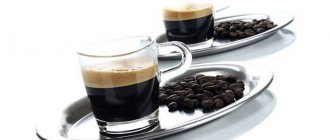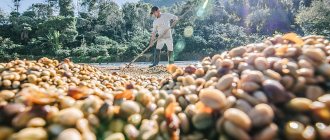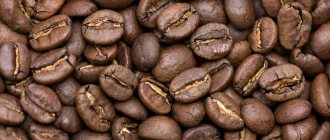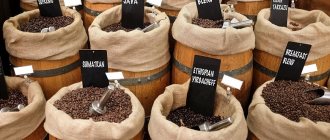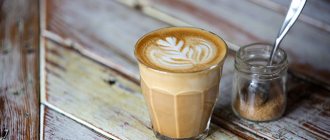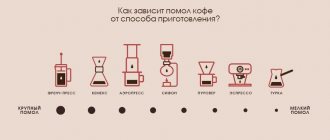A noble drink requires not only adherence to precise preparation recipes, but also decent utensils. The volume of a coffee cup, its appearance, and even the material used to make it are all part of coffee etiquette, which helps you get the most out of your coffee drinking experience. Today we will find out exactly how big a coffee cup should be and why certain sizes are recommended for different types of drink.
Volume of coffee cups for different types of coffee
Coffee utensils differ in their purpose. Each popular recipe has its own variations.
Espresso cups
This basic type of coffee requires small cups. It is served in a tiny container with a volume of 35-40 ml or in a slightly larger one with a capacity of 50-70 ml. Demitasse cups, the size of which is 60-90 ml, are also suitable for espresso.
Why such a volume?
For better preservation of drink temperature and flavor bouquet. Coffee according to this recipe is made in small portions and the task of the cup is not to let it cool.
In modern coffee shops you can more often see espresso in cups up to 90 ml. They are good because they can serve several espresso-based recipes, including lungo or ristretto.
Oriental coffee cups
In order to preserve the temperature and taste of this strong drink, coffee cups with a volume of 70-90 ml are recommended. The ideal choice would be a cup of demitasse. Its egg-shaped internal shape and impressive thickness allow the coffee to stay hot for a long time and preserve the entire flavor bouquet of the recipe. This size is also suitable for most popular recipes based on hand-brewed coffee.
Why such a volume?
Coffee according to oriental recipes has a rich taste and high caffeine content, so it is served in small portions.
Some cezve coffee recipes require very small cups due to their strength. Then use dishes up to 50 ml in size, made of very thick porcelain or ceramics.
Cappuccino cups
The drink requires larger cups compared to espresso, as it is prepared with the addition of milk and high foam. The volume of cappuccino cups is from 170 to 220 ml. No longer necessary - etiquette requires that the portion of this drink be level with the edges of the cup or even slightly rise above them.
Why such a volume?
A classic cappuccino is prepared using espresso and milk in a 2:1 ratio. In addition, the drink has a high foam, which also requires space.
A 170 ml coffee cup is also suitable for serving dopio, lungo, espresso with cream and other coffee recipes, so this volume can be safely called universal.
Americano cups
Espresso, strongly diluted with water, has a volume of 180 to 200 ml, so most often a coffee cup volume of 200-220 ml is chosen for it. Some establishments serve Americano in the same cups as cappuccino, making the drinks the same size.
Why such a volume?
Traditional espresso is diluted with water to a total volume of 180 ml, but serving etiquette requires that the coffee cup not be filled to the brim with Americano, so larger containers are used.
Latte cups
The peculiarity of this recipe is that it contains a large volume of liquid; at least 150 ml of milk is required to make the drink. Therefore, the volume of latte cups is much larger than regular coffee containers. The drink is served in glasses of 220, 250,300 and even 360 ml.
Why such a volume?
Due to the large amount of milk in the recipe.
Frappuccino cups
One of the largest coffee cocktails in terms of volume requires a cup or glass of at least 350 ml. A large portion can reach 500 ml. Therefore, the maximum volume of a coffee cup for a frappuccino is needed, literally, the larger the better.
Why such a volume?
Frappuccino is rather a liquid dessert, so it requires dessert glasses, which always have a significant volume.
Most espresso-based recipes are perfectly fine served in a 170 ml cup. All coffee cocktails with a lot of milk and toppings require a voluminous coffee cup measuring 280-350 ml.
If you are looking for a coffee cup for alternative brewing, for example, using a Chemex or pour-over, a French press or a geyser coffee maker, then opt for a 200 ml container. Natural coffee prepared using these methods is less strong than espresso, so its portions have to be increased. So you will need an appropriate cup.
How is Americano coffee served?
Americano is considered a type of espresso. To prepare the drink, espresso is diluted with a small amount of hot water. As a result, the taste becomes less intense, but this does not affect the aroma of the coffee. To avoid damage to the foam, hot water is poured into the container first, and only then coffee.
The distinctive features of Americano include the following:
- The drink contains less caffeine.
- During the cooking process, you can experiment with grinding and the degree of roasting of the beans. The Scandinavian variety of roasting is considered the most suitable.
- Americano is often prepared in capsule coffee makers.
- To further soften the taste, milk is added to the finished drink.
It is necessary not only to cook correctly, but also to serve Americano. To do this, select a cup with the required volume. The most suitable option is 200-220 ml. The ability of a mug to retain heat is extremely important. Therefore, it must be made of thick porcelain. In some cases, the barista may serve coffee cups and saucers designed for cappuccino.
Choosing the volume of a coffee cup for home, office and coffee shop
For home
If you are looking for dishes for the home, then you should pay attention to universal volumes that are useful for most popular recipes. The optimal choice is a cup with a volume of 170-200 ml. It can be used to prepare cappuccino, cezve coffee, espresso – classic and with additives.
For a coffee shop
Are you choosing tableware for your coffee shop? Then you will need cups of three sizes.
- 70-90 ml for espresso and drinks based on it.
- 180-220 ml for cappuccino and Americano.
- 280-360 ml for coffee cocktails, like lattes, frappuccinos or your own signature treats.
It is better to buy the entire set from one manufacturer. Stylistic uniformity will favorably emphasize the style of the establishment, and you can get a good discount on wholesale purchases.
To the office
Universal coffee cups with a volume of 150-170 ml are suitable for the office. This size will make it possible to satisfy the tastes of almost any guest or colleague.
For office coffee makers, choose neutral cups not only in size, but also in color, this is the recommendation given by psychologists. The versatility of the cookware will not give rise to unnecessary competition.
Espresso cups
Most often, espresso is prepared using Robusta or Arabica, medium ground and dark roast. A distinctive feature in the preparation is the use of a coffee machine, in which the pressure of hot water passes through a compressed layer of raw materials.
Espresso is served in small portions, so the cup must be highly heat resistant. That is why the most suitable material in this case is porcelain.
Before serving, the cups are preheated using hot water or steam. This helps to better reveal the taste of the drink. Espresso lovers are advised to purchase a set of 40 ml coffee cups. A small saucer looks organic with it.
What type of coffee requires cups?
Strong coffee
The stronger your favorite recipe, the smaller the volume of the dishes should be. Gourmets who most like to pamper themselves with a cup of strong black coffee brewed by hand or a shot of scalding espresso from an automatic coffee maker can choose cups up to 100 ml.
We recommend paying attention to demitasse cups, which are ideal for revealing the bouquet of natural freshly brewed coffee. They have the right volume and laconic shape.
Coffee drinks
If you drink coffee in large portions or prefer to dilute the drink with milk, cream, or toppings, then feel free to choose large and cozy cups of 200-300 ml.
Despite the temptation to buy a coffee cup made of thin porcelain, it is better to give preference to dishes with thick walls. In this case, the drink will retain its bouquet of taste and aroma much longer.
Color, wall thickness, shape
The external decor of the dishes can be completely varied, from classic plain white to colorful or abstract designs. This fact does not affect the taste of the drink, so each coffee lover can only focus on his own preferences. But there are several important parameters.
When choosing, you should focus on the thickness of the walls of a cup made of high-quality porcelain or ceramics with a durable coating. To enjoy the taste of a drink, you need to keep it hot, and thin, elegant mugs quickly lose heat, especially with a small volume of liquid. Therefore, such options are not suitable for coffee lovers. The ideal choice is an elongated cup with thick walls that maintains the temperature and prevents you from burning your hands.
An important point is the shape of the container. It is advisable to choose elongated options in the shape of an ellipse or egg. They allow you to enjoy the aroma of coffee and are known as demitasse.
Choosing a coffee pair
If you are planning to buy a coffee pair, you will have to face a difficult choice. Such items come in a huge variety, and it is quite difficult to decide on the required volume, especially if you are planning to buy as a gift. To choose the right size coffee pair, consider a few simple rules.
- Small coffee cups with a volume of 50-90 ml will be appreciated by coffee lovers and admirers who know how and love to prepare it.
- The size of 180-220 ml is suitable for those who like to drink coffee in large portions, with milk and sugar.
- The volume of a coffee cup of 150-170 ml is considered universal, as it is suitable for preparing almost all popular recipes. This size is ideal to buy as a gift for someone whose tastes you practically don’t know. Well, or you know too well!
The volume of a coffee cup for individual use is a deeply personal matter. We interviewed some of the participants in our project and found out that our selection of dishes varies from 250 to 500 ml.
What is the size of your favorite coffee cup?
For Turkish coffee
The oriental variety of coffee is prepared on the stove using a Turkish coffee pot. Distinctive features include a high degree of strength and the presence of sugar, which is added at the beginning of cooking. In Turkey, the coffee ceremony includes a lot of nuances. The finished product is served on the table in a Turk. Each guest is given small ceramic glasses.
For decoration, Turks often use precious metals, stone inserts and colored enamel. Oriental motifs must be traced in the design. In public establishments, in addition to the basic set of dishes, glasses of cold water are served. It must be drunk before every sip of coffee. This allows you to taste the subtleties of its taste.
Your choice is paper
No one expects a wow effect from coffee in paper cups, and most people regard such coffee as a temporary replacement for a full-fledged drink. There is less demand for it! But if the coffee was brewed well and served at the temperature you like, it will seem tastier to you than the same in any other container. After all, reality has exceeded expectations - so you decide subjectively.
Disposable paper cups for hot drinks typically also include plastic for strength and to prevent leakage. “So that buyers don’t think too much about it,” says Charles Spence. “It’s no coincidence that takeaway coffee is often served in brown cups or with a brown ring made from recycled paper or cardboard placed on white utensils. Brown has a strong association with the earth, naturalness and ecology.”
Drinking coffee from paper cups
The tireless Brazilians mentioned above have already studied how the texture of dishes can affect the perception of coffee . In a 2021 experiment, participants were given a smooth or rough (rough) ceramic cup of coffee. The researchers found that coffee served in ceramic mugs with a rough surface was rated as bitter and dry in the aftertaste. Coffee in a smooth cup was perceived as sweeter and more drinkable.
Appearance
There is a division into two main categories:
- Coffee couple. An ordinary saucer and cup, having a wide shape, tapering at the bottom. Widely used in cafes and restaurants.
- Separate cup. It is possible to modify the geometric shape - options with smoother edges.
Second: the prejudice brought by color
Another Australian study found that even the same coffee, but with different colored coffee cups,
You can taste varying degrees of bitterness in your coffee.
George Van Doorn, professor of psychology at the Australian Commonwealth University, invited dozens
people to experiment with clear, white and blue coffee cups and put the same coffee out for testers to try.
A study found that a white cup of coffee is more sensitive than a clear cup of coffee, which makes coffee
the liquid is darker. It feels like the cup of coffee is highly concentrated and will be bitter to drink. Coffee in
the blue cup passes through the blue one. The color contrast with the color of the coffee liquid will make people feel that
The color of the coffee liquid is relatively light, and then the cup of coffee will have a low concentration and will not be very bitter to drink.
The contrast between different colors and coffee can affect people's feelings.
Your choice is plastic
A reusable coffee mug may be ideal for travel, but unlike ceramic and glass, plastic will absorb odors over time. And a subtle sense of smell will definitely catch it, which means the impression of coffee will be spoiled! The lids that are always paired with plastic (both disposable cups for cold coffee and reusable cups for hot coffee) interfere with the perception of such a pleasant aroma. Your nose won't benefit from coffee if you drink it from plastic cups.
It is known that we evaluate aromas in two ways: orthonasal (through the nose) and retronasal (when volatile substances “fly” to the receptors, passing behind the roof of the mouth while eating). So, according to Mr. Spence, “coffee is one of the few drinks where the orthonasal aroma we inhale is often more pleasant than the retronasal one.” The professor is perplexed: “Why are billions of coffees sold in glasses with a plastic lid that does not allow us to truly feel (hear, as experts would say) the aroma of the coffee?”
Drinking iced coffee from a plastic cup
Your choice is ceramics
Ceramic cups also retain heat well, but not as long as glass. The white inner surface of ceramic cups (and most often they are produced just like this: a colored “shirt” and a white inside) provides a good color contrast and presents coffee as a strong and rich drink. Also, you always see the “texture” of the liquid against the background of the inner surface of the cup. It's almost like examining red wine flowing down the sides of a wine glass.
Now about the color! Spence and Fabiana Carvalho of the research University of Campinas in the Brazilian state of Sao Paulo recently conducted a series of psychological experiments. They offered coffee lovers to drink it from ceramic cups of different colors. The coffee, served in pink mugs, always seemed sweet. The strong association of the color pink and the sweet life of a girl in general, and in particular the cream with which pastry chefs so often decorate desserts, played a role here. Not surprisingly, coffee served in a green mug was rated as more sour, and the yellow color gave the drink a debatable sweet and sour taste.
Choosing ceramic utensils for coffee
Frappuccino mug
This coffee cocktail is considered less of a drink and more of a dessert. It is made from cappuccino, to which frothed milk and a serving of ice cream are added.
It has a large volume, so it requires large dishes from 350 ml; coffee mugs with a capacity of up to 500 ml or original glass dessert glasses with transparent walls are often used for it, allowing you to admire the beauty of the drink. Other coffee-based cocktails are also served in such dishes - Freddo, raf, mochaccino, drinks with added chocolate, alcohol, juices, and so on.
Filter coffee or espresso: which is better?
There is no clear answer to this question.
Filter coffee is sometimes the best way to taste all the flavors of unique coffee varieties that cannot be prepared in espresso. The process of making pour-over coffee is slow and soothing, sometimes called slow coffee.
However, the brewing time for filter coffee is not comparable to making espresso. Espresso is prepared completely differently, using completely different techniques, and is an incredibly fast way to get a quick caffeine fix.
Something else to take into account is your own preferences. Due to its thick, creamy consistency, espresso works well with milk. The creaminess of frothed milk usually adds even more sweetness to espresso, and the combination can be enjoyed in drinks like lattes, cappuccinos and flat whites.
Filter coffee, in comparison, tastes cleaner, smoother and less acidic, which means it's more likely to be drunk without milk. This allows you to more clearly appreciate the balance of coffee taste, its flavor shades from floral, citrus to caramel and chocolate.
In the end, your best choice will be whatever suits your preferences. Remember that each method of preparing coffee can produce completely different results depending on the type and origin of the coffee, degree of roast, processing methods, etc.
And that's the most amazing thing about coffee, isn't it? This drink always has a lot of variety to offer. So what do you choose?
Dishes for coffee desserts
The container for desserts based on coffee beans should be tall. This is necessary to hold a voluminous head of whipped cream, chocolate and other decorative elements. Some specimens have a thin leg at the base and a comfortable handle on one side. On average, such mugs hold about 300 ml of liquid.
The preferred materials in this case are glass and ceramics. A thermostat can be used to maintain a certain temperature. There are many coffee desserts that are consumed exclusively cold. Among them are frappe, iced coffee and iced coffee.
To prepare frappe, ice is first crushed. It is placed at the bottom of a tall glass. Coffee is poured on top. The cap is formed from whipped cream and decorated with berries. Sometimes liqueur is added to dessert. Glace is prepared with the addition of ice cream. The basis for iced coffee is strong espresso.



